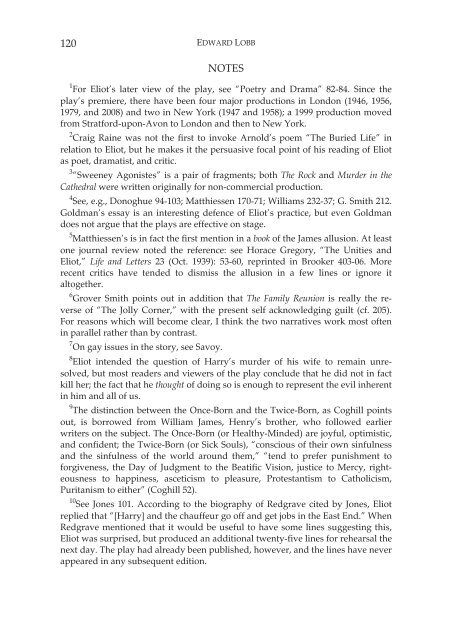Connotations 18.1-3 (2008/2009)
Connotations 18.1-3 (2008/2009)
Connotations 18.1-3 (2008/2009)
Create successful ePaper yourself
Turn your PDF publications into a flip-book with our unique Google optimized e-Paper software.
120<br />
EDWARD LOBB<br />
NOTES<br />
1<br />
For Eliot’s later view of the play, see “Poetry and Drama” 82-84. Since the<br />
play’s premiere, there have been four major productions in London (1946, 1956,<br />
1979, and <strong>2008</strong>) and two in New York (1947 and 1958); a 1999 production moved<br />
from Stratford-upon-Avon to London and then to New York.<br />
2<br />
Craig Raine was not the first to invoke Arnold’s poem “The Buried Life” in<br />
relation to Eliot, but he makes it the persuasive focal point of his reading of Eliot<br />
as poet, dramatist, and critic.<br />
3<br />
“Sweeney Agonistes” is a pair of fragments; both The Rock and Murder in the<br />
Cathedral were written originally for non-commercial production.<br />
4<br />
See, e.g., Donoghue 94-103; Matthiessen 170-71; Williams 232-37; G. Smith 212.<br />
Goldman’s essay is an interesting defence of Eliot’s practice, but even Goldman<br />
does not argue that the plays are effective on stage.<br />
5<br />
Matthiessen’s is in fact the first mention in a book of the James allusion. At least<br />
one journal review noted the reference: see Horace Gregory, “The Unities and<br />
Eliot,” Life and Letters 23 (Oct. 1939): 53-60, reprinted in Brooker 403-06. More<br />
recent critics have tended to dismiss the allusion in a few lines or ignore it<br />
altogether.<br />
6<br />
Grover Smith points out in addition that The Family Reunion is really the reverse<br />
of “The Jolly Corner,” with the present self acknowledging guilt (cf. 205).<br />
For reasons which will become clear, I think the two narratives work most often<br />
in parallel rather than by contrast.<br />
7<br />
On gay issues in the story, see Savoy.<br />
8<br />
Eliot intended the question of Harry’s murder of his wife to remain unresolved,<br />
but most readers and viewers of the play conclude that he did not in fact<br />
kill her; the fact that he thought of doing so is enough to represent the evil inherent<br />
in him and all of us.<br />
9<br />
The distinction between the Once-Born and the Twice-Born, as Coghill points<br />
out, is borrowed from William James, Henry’s brother, who followed earlier<br />
writers on the subject. The Once-Born (or Healthy-Minded) are joyful, optimistic,<br />
and confident; the Twice-Born (or Sick Souls), “conscious of their own sinfulness<br />
and the sinfulness of the world around them,” “tend to prefer punishment to<br />
forgiveness, the Day of Judgment to the Beatific Vision, justice to Mercy, righteousness<br />
to happiness, asceticism to pleasure, Protestantism to Catholicism,<br />
Puritanism to either” (Coghill 52).<br />
10<br />
See Jones 101. According to the biography of Redgrave cited by Jones, Eliot<br />
replied that “[Harry] and the chauffeur go off and get jobs in the East End.” When<br />
Redgrave mentioned that it would be useful to have some lines suggesting this,<br />
Eliot was surprised, but produced an additional twenty-five lines for rehearsal the<br />
next day. The play had already been published, however, and the lines have never<br />
appeared in any subsequent edition.

















